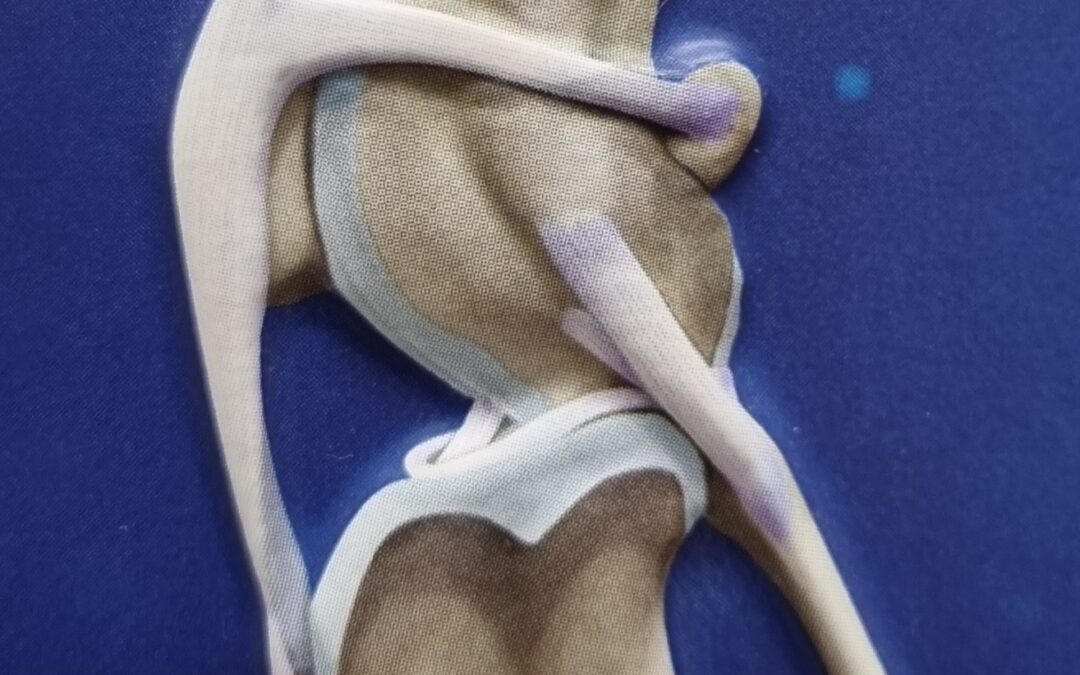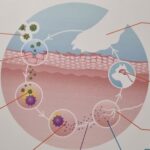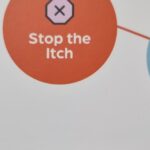CRUCIATE LIGAMENT SURGERY
Please read on for a guide to cruciate surgery and the post-operative period
The aim of surgical treatment of a torn cruciate ligament is to
- Clean up and remove any damaged ligament or meniscal cartilage
- Provide stability to the knee allowing return to function.
- Reduce pain and inflammation
- Reduce further joint damage and arthritis which will always occur to varying degrees after rupture or damage to a cruciate ligament
There are several factors to consider when planning for Cruciate Surgery, which will ultimately effect the longer term outcome and joint management plan.
1. Is this a long standing problems?
2. How much damage has been done?
3. Are there signs of Degenerative joint disease and Osteoarthritis already present?
Surgery can definitely help improve the long term outcomes, and improve both function and comfort. Surgery is however only the first phase of recovery, with healing and strengthening taking up to 6mths in some cases. We expect good return to function with 12 weeks, and some sooner that this. Whilst we expect a reasonable return to function and normal activity in most of our patients, it is important to remember that a damaged joint will never be perfectly normal and in some dogs with severe joint damage the expectation may be to reduce pain and lameness as well as slowing down ongoing joint degeneration.
Post Operative care is as important if not more important in some patients to achieve a successful outcome. It is important to note that we expect most of our patients to be using their leg quite well over the first few weeks after surgery and walking will generally begin after 1-2 weeks, time is still needed to gain full strength. So whilst many patients are keen to get back to normal activity, it is important to ensure that a slow return to normal function is allowed. As with any joint injury, too much activity too soon, can delayed healing and lead to further complications
Home care is therefore equally important to a successful recovery, and a controlled individual rehab plan will be discussed.
SURGICAL PROCEDURES
There are two different surgical procedures that can be performed to stabilize the knee. Both procedures involve a thorough exploration and clean up of the knee joint.
1. D’angelis (Extra capsular Repair) : This is the recommended treatment for smaller dogs
This procedure involves the placement of artificial ligaments that mimic the orientation and action of the cruciate ligament. There are several Extra-Capsular techniques including bone tunnels and anchor screws/pins. We currently use Ligafiba which is one of the strongest synthetic artificial ligaments available. This is usually adequate for small breeds and some medium breed dogs.
Artifical ligaments are never as strong as the original and will loosen in time. But they are important as they act as a scaffold for the fibrous tissue to form along and provide joint stabilization in the healing phase.It is the fibrous tissue around the joint that provided the long term stability to the joint and maintains good joint function. Maximal strength can take up to 6 months, however we expect that by 12-16 weeks there will be adequate strength for dogs to commence reasnablly normal activity levels.
As with any surgical procedure there are a few things we need to be aware of and Complications that can occur.
For a D’angelis procedure these include:
- Premature loosening of the artificial ligament (often with too much activity in the immediate post-operative)
- Wound infection. (Reports suggests < 5%, and even lower in our experience), however a common cause for infection is licking or chewing of the stitches, so ensuring you pet is not able to get to their wound is really important.
- Post-cruciate meniscal injury or tears can occur. The majority of dogs have some degree of damage to their Meniscal cartilage at the time of surgery and will be address at the same time.
–
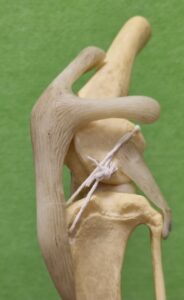
2. TPLO: (Tibial plateau Leveling Osteotomy) – or Closing Wedge Leveling Osteotomy (CWLO).
This is the treatment of choice for larger dogs.
The tibia plateau is the surface that the femur sits on. In many large breed dogs this plateau is very steep and leads to abnormal strain on the cruciate ligament, leading to the high number of cruciate injuries we see in large breed dogs. If the plateau was level then there would be less strain and tension on the cruciate ligament, and reduced instability of the joint.
A TPLO procedure aims to change the angle of the tibial plateau making it more level. Leveling of the tibial plateau is achieved by cutting the bone and removing a small wedge from the tibia. The bone is held in its new position by a stainless steel plate and screws. We now use the more advanced Evolox, locking plate technology which is stronger and has less chance of implant loosening.
Leveling the tibial Plateau improves to the bio-mechanical forces acting on the knee, which results in increased stability of knee and prevents abnormal movement during activity. The cruciate ligament is not replaced and studies have shown that the knee works perfectly well without it, providing the angle is level enough.
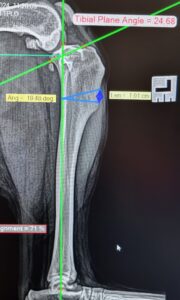
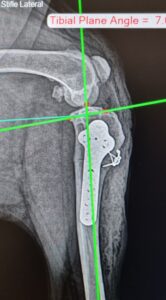
Active dogs and Larger breeds tend to benefit greatly from this procedure. The benefits include
• Allows faster recovery times resulting in less muscle wastage.
• Provides a better long term prognosis for reducing degenerative joint disease and the progression of osteoarthritis, which is inevitable with such injuries
Possible Complications of a TPLO include:
• Early implant loosening / breakage of screws or bending of the plate
• Delayed bone healing.
(Strict confinement and a slow gradual build up of controlled activity greatly reduces the risk of these problems)
• Infection (< 5%)
• Further cartilage damage
Meniscal Cartilage Damage
Each stifle or knee joint has two pieces of cartilage called a Mensicus. These act as a shock absorber to distribute the weight of the dog through the joint evenly and protect the bone. It is very common to have tears or damage to the Menisci after damage to a cruciate ligament. This is because the jonit become sunstable and the menisci get crushed About 50% of patients who tear their Cruciate Ligament will also tear their meniscal cartilage. Meniscal damage will cause increased pain and leads to further joint degeneration and osteoarthritis forming. It is vitally important to a succcessful outcome that the meniscus is thoroughly examined and any damaged meniscus is removed at time of surgery.
It is also possible for late meniscial tears to occur weeks or months after the initial cruciate damage, and would need to be cleaned up.
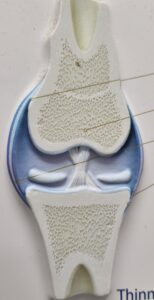
THINGS TO KEEP IN MIND
Whilst we now that once the cruciate ligament is torn the damaged joint will always develop a degree of Degenerative Joint Disease ( DJD) and osteoarthritis. It is however clear that that early surgical treatment will greatly reduce the degree of DJD and Osteoarthritis, which obviously helps improve longer term comfort levels.
Longer standing injuries especially those with existing evidence of arthritis ( as seen on screening X-rays) would also greatly benefit from ongoing joint management.
EXTRA MEASURES
We also feel that a few extra measures can be taken to improve the immediate and postoperative comfort of your pet.
• IV Fluids: All animals are placed on an intravenous drip prior to, and during the general anaesthetic to help maintain blood pressure, but also deliver intravenous medications.
• Pain Management: Patient comfort is very important and patients are given several forms of pain relief,
1. Intravenous Methadone pain relief injections before surgery and during their hospital stay after surgery.
2. Additional pain relief in the way of anti-inflammatory medications is given by an injection immediately after surgery followed up by a course of medication to be administered at home.
3. Local Anaesthetic is infused directly into the joint at time of surgery to further decrease pain.
4. fentanyl Pain Patch provided after Surgery
5. Synovan Course involving 4 weekly injections
6. Compression bandage
8. Laser Therapy
• Antibiotics: Intravenous antibiotics are used routinely prior to, during, and after the surgery to help minimize the risk of infections. A short course is also provided to be administered at home. You can help reduce the infection risk by ensuring your pet is not able to lick or chew their wound.
HOME CARE AFTER SURGERY
- We aim for an initial 12-16 week recovery period followed by controlled activity for several months after that to allow strengthening
- REST and CONFINEMENT: is as important as the surgery and is needed to help healing and reduce the risk of complications with over exertion.
- Initial confinement to a pen or small room
- Toileting on lead only – no OFF lead until advised
- No running or jumping until advised.
• For all patients with cruciate ligament disease, a course of Synovan (active Ingredient being Pentosan Polysulphate) is included in the surgery. Synovan is a disease modifying Osteoarthritis Medication (DMOAD). It helps to reduce pain and inflammation from degenerative joint disease. It is a combination of Pentosan and Glucosamine which provides concentrated ant-inflammatory relief and stimulates active joint cartilage repair. Regular use can help improve joint lubrication and slow down the progression of degenerative joint disease thereby reducing ongoing inflammation and pain.
REHABILITATION
A 4 week post-operative rehabilitation program is included in surgery. This is an integral part of the recovery process in humans and so we feel should be part of our pets recovery too
Rehabilitation sessions include
- Laser Therapy :
- A break through in aiding recovery which is painless and drug free
- Helps with better pain relief, reduces inflammation, improves circulation and rate of healing.
- Massage and Range of motion exercises to improve mobility, plus Joint stretches
- Patients generally enjoy their rehabilitation stays and feel more comfortable and mobile afterwards.
Each individual’s progress will be also assessed at the weekly visits and any problems or questions addressed.
A postoperative treatment plan will be discussed with you regarding exercise that can be performed at home.
PROGNOSIS
Early diagnosis and treatment greatly improves the prognosis. Whilst the injured leg will never be normal, with early surgery we expect a 90% return to function. Chronic and long term injuries that may have signs of degenerative joint disease (DJD) and arthritic changes present at the time of treatment often have on going joint stiffness which will need to be managed.
Other measures that can help manage DJD and Osteoarthritis include
• Weight management and regular controlled exercise.
• Synovan/Pentosan “anti-arthritic” injections used as regular maintenance after the recovery phase
• Neutroceuticals such as those found in Hills J/D diet to provide glucosamine and other building blocks of joints.
• Antinol natural joint antinflammatory
• Omega supplements
Should you have any further questions please feel free to ask one of our Veterinarians.
